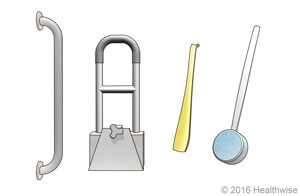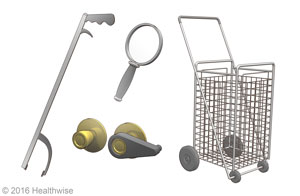Assistive Devices for People With Disabilities
Overview
Assistive devices are tools that help make your daily activities easier. You may also hear them called adaptive equipment.
These tools can help you with many activities, like bathing, grooming, dressing, walking, writing, or eating. They can be simple or complex. They range from a fork with an extra-large handle to a power wheelchair.
Occupational therapists and physical therapists are trained to help you learn what assistive devices can help you. They can also tell you where you can find them. In general, you can find these tools in drugstores, medical supply stores, or online. Some can be found in home improvement stores.
What are some examples of assistive devices?
Tools for grooming and dressing

Examples include:
- Tub or shower grab bars. They can help you get in and out of the bathtub.
- Tools to help you get dressed. These include button or zipper hooks, shoehorns, and sock aids.
- Toothbrushes, combs, and brushes that have big handles. They are easier to hold.
- Long-handled sponges for bathing.
- Velcro fasteners on clothes and shoes instead of small buttons, snaps, or laces.
- Large pull tabs on zippers. These make zippers easier to hold and pull.
Tools for daily tasks

These tools include:
- Stools, carts, trash cans, and other objects on wheels so they can be pushed rather than carried or lifted.
- Doorknob extenders. They help you open doors without twisting the doorknob.
- Molded or padded handles. They can make objects like keys, kitchen gadgets, combs, mirrors, and toothbrushes easier to hold.
- Reaching or grabbing tools. You can use them to help you pick up items from the floor or from a high shelf.
- Writing and reading tools, such as grips on pens or a magnifying glass to help you read.
Tools for moving around

Examples include:
- Movement devices, such as canes, braces, walkers, and electric scooters. Wheelchairs can also help you be mobile.
- Raised toilet seats, with or without rails to help you sit and stand. They can make it safer and easier to use the toilet.
- Special lifts that can help you get in and out of your bed, car, or bathtub.
Related Information
Credits
Current as of: July 24, 2025
Author: Ignite Healthwise, LLC Staff
Clinical Review Board
All Ignite Healthwise, LLC education is reviewed by a team that includes physicians, nurses, advanced practitioners, registered dieticians, and other healthcare professionals.
Current as of: July 24, 2025
Author: Ignite Healthwise, LLC Staff
Clinical Review Board
All Ignite Healthwise, LLC education is reviewed by a team that includes physicians, nurses, advanced practitioners, registered dieticians, and other healthcare professionals.


